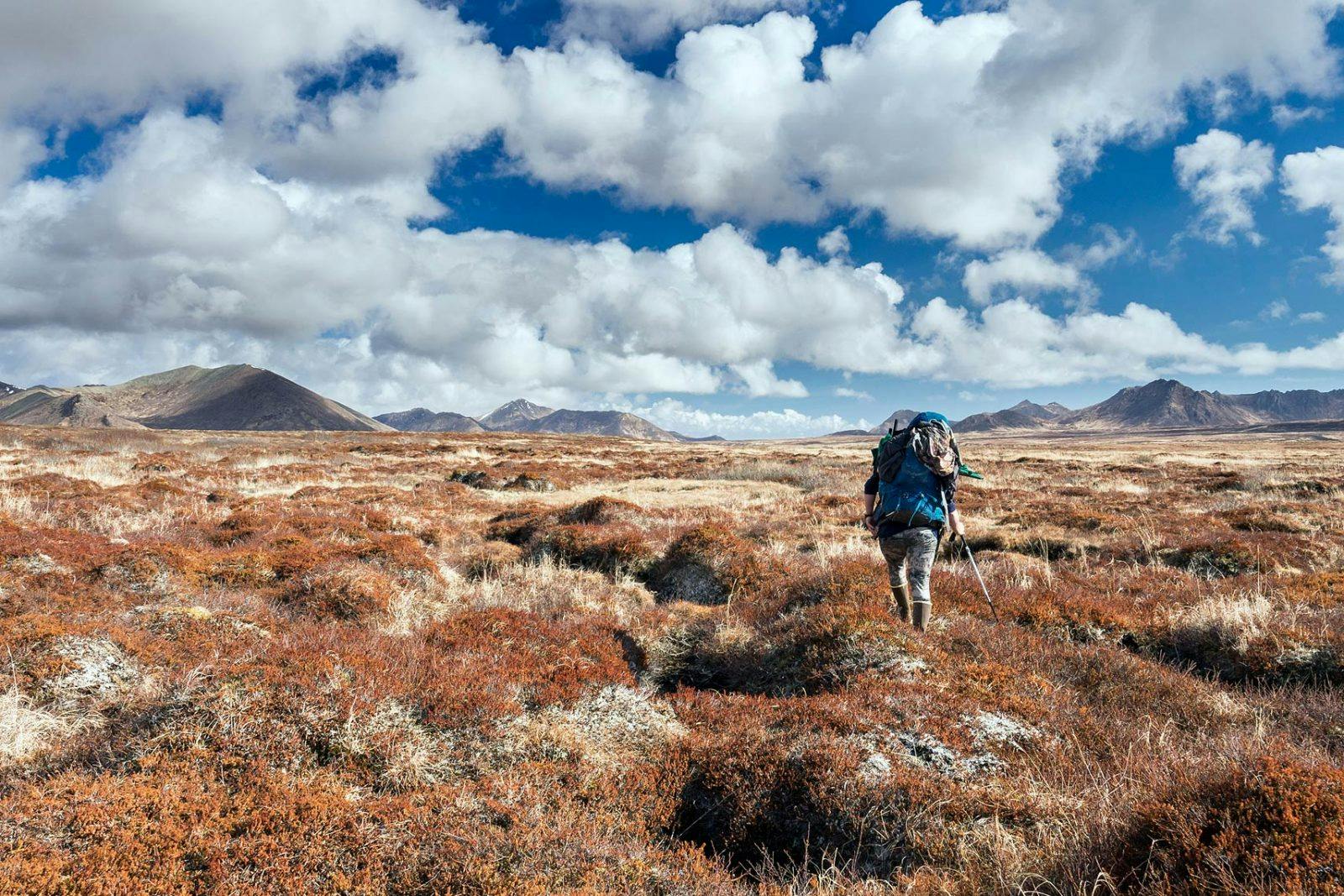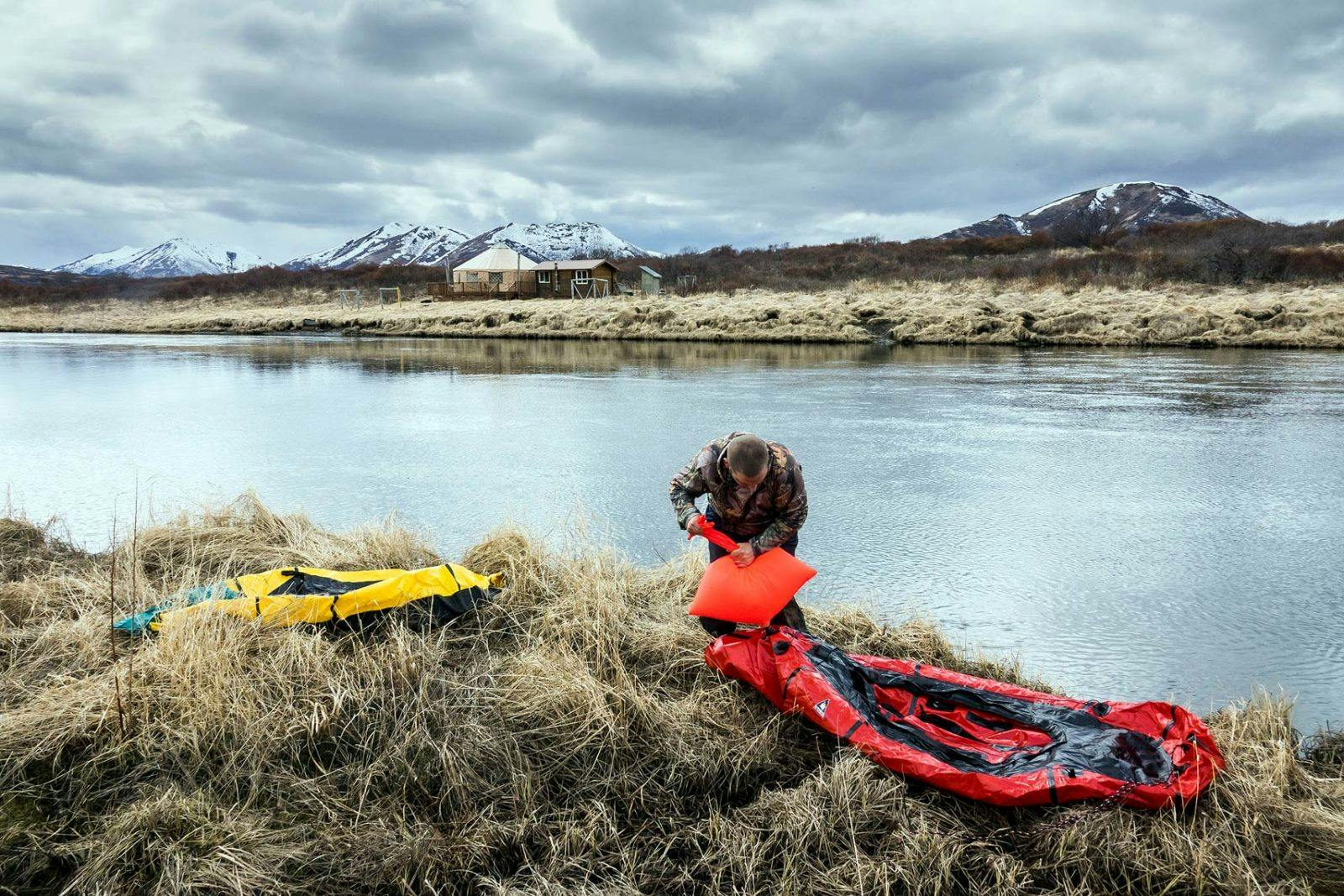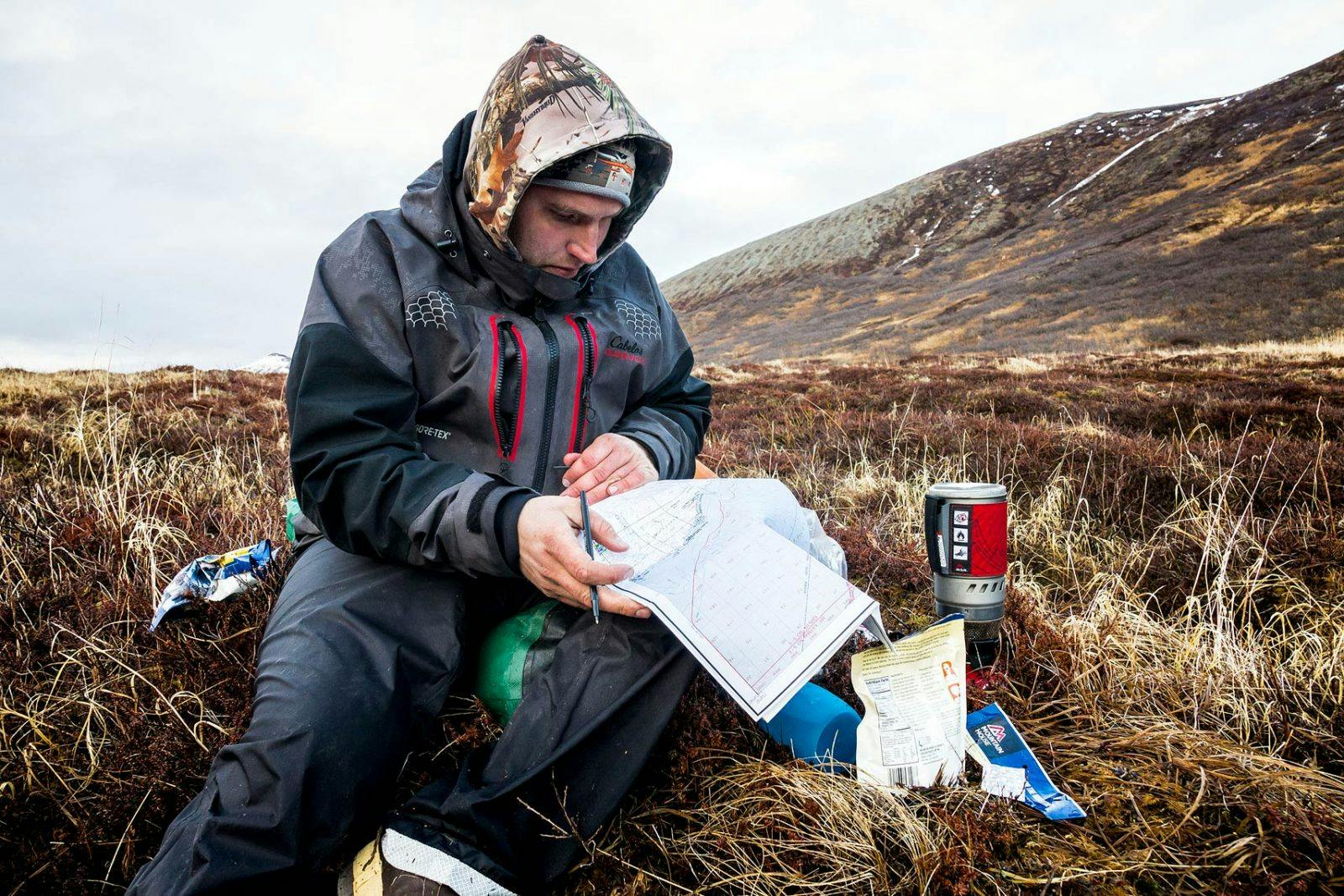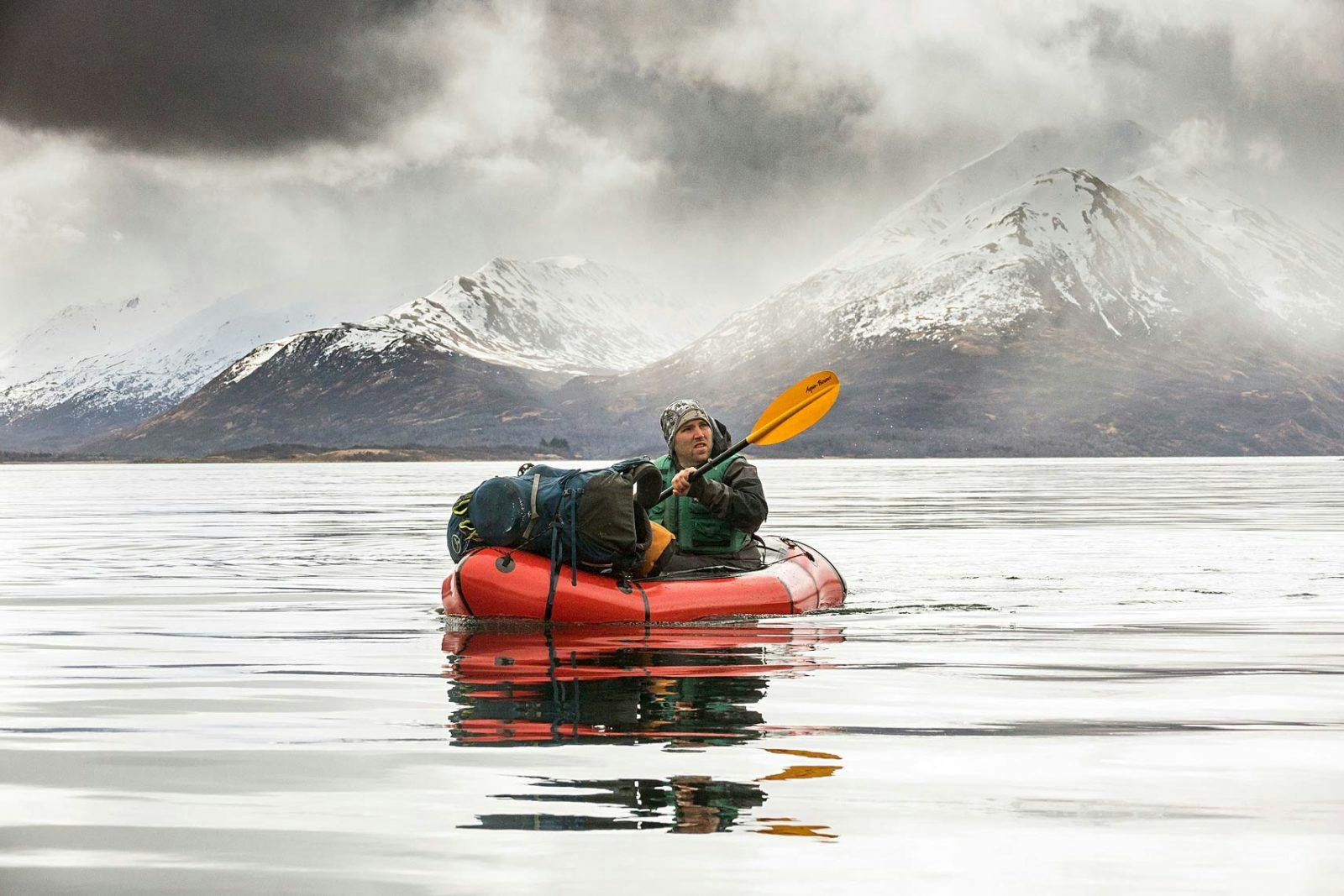Two Best Friends Hike & Packraft Across Kodiak Island Seeking Solitude and Brown Bears
Follow us on Instagram to see more of Chris Miller’s photos from this trip.
Story by Bjorn Dihle and photos by Chris Miller. Cover photo: Footsteps, at right, worn into the landscape from years and generations of Kodiak brown bears walking the bluff along the western edge of Kodiak Island; overlook a black sand beach and the Pacific Ocean.
“You’re going to hike across Kodiak Island?” asked the woman sitting next to me on the Alaska Airlines plane. “Are you crazy?”
“I was just let out of a psych ward,” I said, which was the truth. I spend winters working in the mental health unit in Juneau. In late April I’m released to run around with bears and wander wild places. The plane shuddered in the gray chaos of a Gulf of Alaska storm, and the captain got on the intercom.
“Waves and salmon have flooded the runway, but don’t worry. Kodiak is my home town; I’ll get you there,” he said.

When we emerged from the foggy deluge we were at sea level and waves were within a few inches of crashing over the runway. The plane jolted down and a number of passengers screamed. I was bugling on the inside; after a year of scheming I was finally setting foot on Kodiak to explore a 130-mile loop by foot and packraft across the western portion of the island. I’d planned to do it alone, but the winter before I’d gone out to a bar with my friend photographer Chris Miller. He got me drunk, tricked me into confessing my spring plan, and then decided a long walk amidst biggest brown bears on Earth was a great idea. From our vantage points on bar stools, where we did our planning and talked of training while drinking beer and eating nachos, the trip almost seemed too easy.
Chris arrived to Kodiak a day earlier to visit his aunt and uncle, Jeanne and Brett, who generously helped us with logistics. They picked me up and we headed to the Kodiak Island Brewery. I was horrified to encounter an eclectic mixture of folks, many of whom were dressed in khakis and smelled like they bathed often. Seeing Kodiak so gentrified made me nostalgic for the smell of two-week-old halibut slime and stale Rainier. At least the conversation in every group seemed to be about bears. Men talked about what guns were best for putting one down. Women talked about how the school went on lock-down whenever one was near. A lady, hearing of our walkabout, looked at us with wonder.
“And why do you want to do this?” she asked.
“Our home lives are bad,” I said.
We were delayed by weather so terrible it was awe-inspiring. We wandered the flooded streets, staring out at sea birds riding swells of black ocean and wondering if our plan was anything short of crazy. An armada of commercial fishing boats and infrastructure surrounded the small city—I’d never seen a small city so invested in maritime industries. Clouds lifted two days later and we hopped on a small plane and flew to the Alutiq village of Larsen Bay. A number of men in camouflage sized us up and asked what we were doing.
“We’re going to try to hike to Olga Bay,” I said, failing to mention this was only the halfway point of our journey.
“You can’t hike to Olga Bay!” a bear hunting guide retorted. His client, a large middle-aged man with braces, stood by listening.
“I hiked a lot,” the hunter said.
“You sure did, and you shot your bear!” the guide said.
Chris and I snuck away, but were quickly hailed by a man smoking a cigarette. He told us he was the chief of Larsen Bay and that we needed a permit, with a price tag that made both of us feel queasy, to cross land owned by the Koniag Native Corporation. He also thought we were nuts and went so far as to mention he’d grab any cool gear we had if a bear ate us. Despite all the hype in the media about Kodiak bears, there’s only been one documented case of a person being killed in the archipelago in the last 75 years.

A few dollars poorer, we walked out of town, into brush and past numerous winter-killed deer until we hit the beach. I got tingly when I saw the first set of bear tracks. They were as big as the largest I’d seen on the islands of Admiralty and Chichagof, where I work as bear viewing guide during the warmer months. We followed the bear up an ATV trail, hollering at every corner. I wanted to see a Kodiak, but not at the expense of overly stressing the animal or getting nibbled on. The landscape, barren, wide-open valleys surrounded by mountains, was more pleasant than I expected. With all the “man literature” Kodiak has generated I thought we’d be suffering a little more.
“I’ll never become a man!” I said.
“Me either. It sounds like too much work anyway,” Chris said.
The lovely Karluk River cut through a valley. Before colonization there were dozens of Alutiq villages and camps along its banks and lagoon, all depending on prolific runs of salmon. Now, besides the small village of Karluk on the coast, the river was without people. We inflated Alpacka rafts—one of the most revolutionary inventions for backcountry travel—and floated the shallow current past numerous deer. For thousands of years the only large animal on the island was the brown bear. Since Russian colonization, numerous animals from Sitka black-tailed deer to beaver had been introduced in an attempt to “make the island a sportsman’s paradise.”
In the late evening, after pitching a tent in the rain and a quick dinner, we hiked through brush to the top of a ridge. The peaks above Karluk Lake rose in the gray distance. A number of record bears, animals that stood over ten feet tall and weighed more than 1,500 pounds, had been killed there. If all went well, we planned to return to Larsen Bay via Karluk Lake in around nine days.
In the muddy lagoon of the Karluk River, we stared out at giant cliffs above the Shelikof Strait. The infamously stormy strait was named after Russian fur merchant Grigory Shelikov, who arrived in charge of two heavily armed ships to Three Saints Bay on the south side of the island in 1784. After two decades of Koniag people repulsing Russian fur hunters, Shelikov was determined to establish a permanent colony. A massacre ensued with Russians slaughtering hundreds, mostly with cannons. When the smoke cleared, Shelikov had subjugated an entire people and established the first capital of Russian Alaska.
Under Shelikov’s rule, Karluk became a Russian outpost a few years later. The silent village felt heavy with ghosts. Derelict canneries dotted the bay. Once, more salmon were caught here than Bristol Bay, but those runs were mostly gone. On an eroding bluff, above old houses and shacks gradually falling into the ocean, stood the Ascension of Our Lord Russian Orthodox Chapel. Believed to be the oldest existing church in Alaska, it too will likely soon be claimed by the eroding bluff and ocean. I walked through the graveyard—it seemed everyone buried here had died young—and was happy to climb a mountain and stare out on the wild expanse of the next leg of our journey.

That night we camped in a narrow mountain valley next to a small, frozen lake. A cross fox approached while we made dinner. From a den on a mountain, its pup called for it long into the twilight. Not just the human history of Kodiak felt haunted. Dozens of dead deer lay scattered amidst tundra and brush. By the end of our trip, we would see more than a hundred. In the last century the 1912 Novarupta Volcano eruption ravaged the island and its wildlife with ash, acid rain and starvation. In 1964, the Good Friday Earthquake and its resulting tsunamis devastated the people, the land and the wildlife.
In the chilly morning, as the sun rose magically above mountains and coffee boiled, I shrugged off dark thoughts and studied a landscape so beautiful it was hard to take in. We hiked across tundra, low mountains and lagoons. No bears appeared. It was a cold spring; maybe most were still snoozing in their dens. We saw skulls of reindeer and caught a glimpse of a lone animal grazing the tundra above Halibut Bay. We followed miles of sandy beach as the surf cascaded pebbles. On a bluff above the old village site of Ayakulik, an emaciated doe wobbled. Below, harbor seals bobbed in the waves at the mouth of the lagoon. There was nowhere to walk except right next to her.
“Hang on for just a little longer and spring will come,” I said to her as Chris and I slowly stepped past.
That night we camped on a bluff next to a bear trail where generations of animals had stepped in the same place. A fox picked through molted king crab shells scattering the shore of Olga Bay. We passed set-net cabins and a bear hunting camp protected by an electric fence. A low pass led to Akalura Lake, which was surrounded by bear trails as big as bike paths. In a few months this place would be impossible to travel without close encounters. Whenever trails petered out, travel was brushy, and by the time we reached the southern edge of Frazer Lake, we were pleasantly surprised to find a short trail that led to Dog Salmon Creek falls, a bear-viewing area. Even more surprising was how much infrastructure was in place, including several cabins, platforms, a weir and fish ladders.
It was early May now and we still hadn’t seen a bear. I was getting worried we’d return home skunked. That evening, though, as we worked our way through a forest of cottonwoods, we saw our first Kodiak. The bear looked like an adult male on the prowl for a mate. It stared at us and sniffed the air. I’d been approached by horny boars a number of times. Neither Chris nor I wanted to go that way, so we made it clear we were people and just passing through. Slowly, the great animal lumbered away, leaving us feeling electric.
Like some sort of wilderness magic, bears began appearing on the mountains above Karluk Lake. They grazed, dug roots and napped. Mated pairs lazed and fed next to each other. Most were the same color of the yellowish-brown slopes. We counted twelve bears by the time we reached the north shore of the lake, where the river begins. I could now comfortably confirm what they say about Kodiak bears—they’re huge! A mother and her two spring cubs grazed on a ridge we were considering hiking as we checked my InReach. A message from a friend told of a big weather system that would hit Kodiak the following afternoon; he advised trying to get on the morning flight out of Larsen Bay if we didn’t want to get stuck in the storm. Instead of hiking the mountain, we paddled down the Karluk River, past flocks of goldeneyes, mergansers, pin-tails, cinnamon teal and shorebirds. Tundra swans winged over and set down in a slough.
We shouldered our packs and hiked to the low pass above Larsen Bay we’d stood on nine days before.Tomorrow we’d barely beat a storm back to the town but, right then, the evening sun bathed the mountains in soft light. Silently, I thanked the land, animals and spirits of Kodiak for letting us visit before following my friend down to the ocean.
Bjorn Dihle is a Juneau writer. His first book is “Haunted Inside Passage: Ghosts, Legends and Mysteries of Southeast Alaska.” Contact or follow him at www.facebook.com/BjornDihleauthor.


